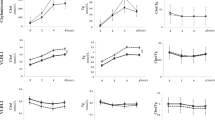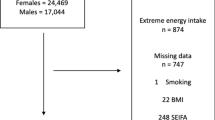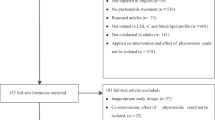Abstract
Background:
Studies on effectiveness of phytosterol/-stanol-enriched margarines in the community have received low priority. For postlaunch monitoring purposes including risk–benefit analyses, it is needed to investigate both exposure and effectiveness of these margarines.
Objective:
To study the use and effectiveness of phytosterol/-stanol-enriched margarine.
Design, setting and subjects:
The study population consisted of 2379 subjects that participated in a community intervention study (‘Hartslag Limburg’) aged 28–76 years. In 1998 and 2003, blood samples for total and high-density lipoprotein (HDL) cholesterol were obtained. A general questionnaire and food frequency questionnaire (FFQ) were administered. From 1999 onwards, phytosterol/-stanol-enriched margarines were introduced on the Dutch market. On the basis of 2003 data, subjects were classified in users of (a) phytosterol/-stanol-enriched margarine, (b) cholesterol-lowering drugs, (c) the combination (both enriched margarine and drugs) and (d) neither enriched margarines nor cholesterol-lowering drugs.
Results:
Mean (±s.d.) daily intake of phytosterol-enriched margarine (n=99) and phytostanol-enriched margarine (n=16) was 14±9 g. From 1998 to 2003, total serum cholesterol concentration changed significantly different among the four groups: in the combination users −2.04±1.50 mmol/l (−29%), in cholesterol-lowering drug users −1.09±1.17 mmol/l (−17%), in the enriched margarine users −0.24±0.75 mmol/l (−4%) and in non-users +0.10±0.72 mmol/l (+2%)(P<0.05).
Conclusion:
Recommended doses are not consumed, but phytosterol/-stanol-enriched margarines can modestly reduce serum total cholesterol in the community. These margarines cannot equal the effect of cholesterol-lowering drugs, but may act additively. Further investigation of the health effects that may occur during simultaneous cholesterol lowering drugs and phytosterol-or –stanol-enriched margarines usage is important, as well as community education about the cholesterol lowering foods and drugs.
Sponsorship:
Netherlands Organization for Health Research and Development (ZonMW) (data collection of Hartslag Limburg and further data- analyses).
This is a preview of subscription content, access via your institution
Access options
Subscribe to this journal
Receive 12 print issues and online access
$259.00 per year
only $21.58 per issue
Buy this article
- Purchase on Springer Link
- Instant access to full article PDF
Prices may be subject to local taxes which are calculated during checkout

Similar content being viewed by others
References
Anonymous (2001). Executive summary of The Third Report of The National Cholesterol Education Program (NCEP) expert panel on detection, evaluation, and treatment of high blood cholesterol in adults (adult treatment panel III). JAMA 285, 2486–2497.
Baigent C, Keech A, Kearney PM, Blackwell L, Buck G, Pollicino C et al. (2005). Efficacy and safety of cholesterol-lowering treatment: prospective meta-analysis of data from 90 056 participants in 14 randomised trials of statins. Lancet 366, 1267–1278.
Blair SN, Capuzzi DM, Gottlieb SO, Nguyen T, Morgan JM, Cater NB (2000). Incremental reduction of serum total cholesterol and low-density lipoprotein cholesterol with the addition of plant stanol ester-containing spread to statin therapy. Am J Cardiol 86, 46–52.
Blokstra A, Verschuren WMM (2006). Veranderingen in leefstijl- en risicofactoren voor chronische ziekten met het ouder worden: De Doetinchem Studie 1987–2002. National Institute for Public Health and the Environment Bilthoven, The Netherlands. Report No. 260401003.
Christiansen LI, Lahteenmaki PL, Mannelin MR, Seppanen-Laakso TE, Hiltunen RV, Yliruusi JK (2001). Cholesterol-lowering effect of spreads enriched with microcrystalline plant sterols in hypercholesterolemic subjects. Eur J Nutr 40, 66–73.
de Jong N, Buurma-Rethans E, Fransen H, Ocke MC (2005). Postlaunch monitoring of functional foods (II) - methodology development. National Institute for Public Health and the Environment (RIVM), Bilthoven, The Netherlands. Report No. 350030005.
Dutch National Organization for Qualitative Assurance in Hospitals (CBO and Centraal Begeleidingsorgaan voor de Intercollegiale Toetsing) (1998) Consensus cholesterol: treatment and prevention of coronary heart disease by reduction of serum cholesterol concentration (in Dutch), Second revision.
European Atherosclerosis Society (1987). Strategies for the prevention of coronary heart disease: a policy statement of the European Atherosclerosis Society. Eur Heart J 8, 77–88.
Gylling H, Radhakrishnan R, Miettinen TA (1997). Reduction of serum cholesterol in postmenopausal women with previous myocardial infarction and cholesterol malabsorption induced by dietary sitostanol ester margarine: women and dietary sitostanol. Circulation 96, 4226–4231.
Hendriks HF, Brink EJ, Meijer GW, Princen HM, Ntanios FY (2003). Safety of long-term consumption of plant sterol esters-enriched spread. Eur J Clin Nutr 57, 681–692.
Hendriks HF, Weststrate JA, van Vliet T, Meijer GW (1999). Spreads enriched with three different levels of vegetable oil sterols and the degree of cholesterol lowering in normocholesterolaemic and mildly hypercholesterolaemic subjects. Eur J Clin Nutr 53, 319–327.
Houterman S, Verschuren WM, Oomen CM, Boersma-Cobbaert CM, Kromhout D (2001). Trends in total and high density lipoprotein cholesterol and their determinants in The Netherlands between 1993 and 1997. Int J Epidemiol 30, 1063–1070.
Hulshof KFAM, Ocké MC, van Rossum CTM, Buurma-Rethans EJM, Brants HAM, Drijvers JJMM et al. (2003). Results of the Dutch National Food Consumption Survey 2003. Report of the National Institute for Public Health and Environment (RIVM) Report No. 350030002.
Katan MB, Grundy SM, Jones P, Law M, Miettinen T, Paoletti R (2003). Efficacy and safety of plant stanols and sterols in the management of blood cholesterol levels. Mayo Clin Proc 78, 965–978.
Kattermann R, Jaworek D, Moller G, Assmann G, Bjorkhem I, Svensson L et al. (1984). Multicentre study of a new enzymatic method of cholesterol determination. J Clin Chem Clin Biochem 22, 245–251.
Law MR (2000). Plant sterol and stanol margarines and health. West J Med 173, 43–47.
Law MR, Wald NJ, Thompson SG (1994). By how much and how quickly does reduction in serum cholesterol concentration lower risk of ischaemic heart disease? BMJ 308, 367–372.
Lea LJ, Hepburn PA (2006). Safety evaluation of phytosterol-esters. Part 9: Results of a European post-launch monitoring programme. Food Chem Toxicol 44, 1213–1222.
Lopes-Virella MF, Stone P, Ellis S, Colwell JA (1977). Cholesterol determination in high-density lipoproteins separated by three different methods. Clin Chem 23, 882–884.
Luoto R, Simojoki M, Uutela A, Boice Jr JD, McLaughlin JK, Puska P (2004). Consistency of use of plant stanol ester margarine in Finland. Public Health Nutr 7, 63–68.
Miettinen TA, Gylling H, Lindbohm N, Miettinen TE, Rajaratnam RA, Relas H (2003). Serum noncholesterol sterols during inhibition of cholesterol synthesis by statins. J Lab Clin Med 141, 131–137.
Miettinen TA, Puska P, Gylling H, Vanhanen H, Vartiainen E (1995). Reduction of serum cholesterol with sitostanol-ester margarine in a mildly hypercholesterolemic population. N Engl J Med 333, 1308–1312.
National Institute for Public Health and the Environment, RIVM 2005: www.rivm.nl/vtv/object_document/o1309n17964.html(in Dutch), 28 November 2005.
Nauck M, Marz W, Jarausch J, Cobbaert C, Sagers A, Bernard D et al. (1997). Multicenter evaluation of a homogeneous assay for HDL-cholesterol without sample pretreatment. Clin Chem 43, 1622–1629.
Neil HA, Huxley RR (2002). Efficacy and therapeutic potential of plant sterols. Atheroscler Suppl 3, 11–15.
Ntanios FY, Homma Y, Ushiro S (2002). A spread enriched with plant sterol-esters lowers blood cholesterol and lipoproteins without affecting vitamins A and E in normal and hypercholesterolemic Japanese men and women. J Nutr 132, 3650–3655.
Ocke MC, Bueno-de-Mesquita HB, Goddijn HE, Jansen A, Pols MA, van Staveren WA et al. (1997). The Dutch EPIC food frequency questionnaire. I. description of the questionnaire, and relative validity and reproducibility for food groups. Int J Epidemiol 26 (Suppl 1), S37–S48.
Patch CS, Tapsell LC, Williams PG (2005). Plant sterol/stanol prescription is an effective treatment strategy for managing hypercholesterolemia in outpatient clinical practice. J Am Diet Assoc 105, 46–52.
Perisee DM (2005). Food fortification with plant sterol/stanol for hyperlipidemia: Management in free-living populations. J Am Diet Assoc 105, 52–53.
Pols MA, Peeters PH, Ocke MC, Slimani N, Bueno-de-Mesquita HB, Collette HJ (1997). Estimation of reproducibility and relative validity of the questions included in the EPIC Physical Activity Questionnaire. Int J Epidemiol 26 (Suppl 1), S181–S189.
Ronda G, Van Assema P, Ruland E, Steenbakkers M, Brug J (2004). The Dutch Heart Health Community Intervention ‘Hartslag Limburg’: design and results of a process study. Health Educ Res 19, 596–607.
Ruland E, Harting J, van Limpt P, Ronda G, Van assema P, Van Ree J et al. (1999). Hartslag Limburg': a united approach in preventive care. GGD-zzl, Maastricht.
Schuit AJ, Wendel-Vos G, Verschuren WMM, Ronckers ET, Ament A, van Assema P et al. (2006). Effect of 5-year community intervention Hartslag on cardiovascular risk factors. Am J Prev Med 30, 237–242.
Scientific Committee on Food (2003). Opinion of the scientific committee on food on applications for approval of a variety of plant sterol-enriched foods.
Vanstone CA, Raeini-Sarjaz M, Parsons WE, Jones PJ (2002). Unesterified plant sterols and stanols lower LDL-cholesterol concentrations equivalently in hypercholesterolemic persons. Am J Clin Nutr 76, 1272–1278.
Verschuren WMM, Boerma GJ, Kromhout D (1994). Total and HDL-cholesterol in The Netherlands: 1987–1992. Levels and changes over time in relation to age, gender and educational level. Int J Epidemiol 23, 948–956.
Wolfs M, de Jong N, Ocké MC, Verhagen H, Verschuren WMM (2006). Effectiveness of customary use of phytosterol/-stanol-enriched margarines on blood cholesterol lowering. Food Chem Tox 44, 1682–1688.
Acknowledgements
The data collection in Maastricht was financially supported by The Netherlands Organization for Health Research and Development (ZonMW). We thank the field workers of the Municipal Health Service in Maastricht for their contribution to the data collection of this study, in particular R Veldkamp and J de Vreede. Project leader was Dr AJ Schuit, project coordination was performed by GCW Wendel-Vos. Data management was performed by A Blokstra, logistic support by PE Vissink and E Goddijn and secretarial assistance was provided by T van den Brink. Finally, we would like to thank ZonMW for supporting M Wolfs (grant number 014-12-010).
Author information
Authors and Affiliations
Corresponding author
Additional information
Guarantor: N de Jong.
Contributors: NdJ and JMAvR are nutrition scientists, MCJW, a human health scientist, who are working at the Centre for Nutrition and Health, the National Institute of Public Health and the Environment (RIVM), The Netherlands. They were responsible for the concept of the paper, the finalising of the data analyses and the writing process. AZ was at the time of the study a master's degree candidate who performed the analyses and wrote main parts of the paper. GCWW-V and AJS are both epidemiologists and working at the Centre for Prevention and Health Services Research (RIVM), The Netherlands. They were study manager and study director of the HL study, respectively, and participated in the data analysis process and commented on the manuscript.
Rights and permissions
About this article
Cite this article
de Jong, N., Zuur, A., Wolfs, M. et al. Exposure and effectiveness of phytosterol/-stanol-enriched margarines. Eur J Clin Nutr 61, 1407–1415 (2007). https://doi.org/10.1038/sj.ejcn.1602660
Received:
Revised:
Accepted:
Published:
Issue Date:
DOI: https://doi.org/10.1038/sj.ejcn.1602660
Keywords
This article is cited by
-
The effectiveness and cost-effectiveness of plant sterol or stanol-enriched functional foods as a primary prevention strategy for people with cardiovascular disease risk in England: a modeling study
The European Journal of Health Economics (2018)
-
Modelling approach to simulate reductions in LDL cholesterol levels after combined intake of statins and phytosterols/-stanols in humans
Lipids in Health and Disease (2011)



